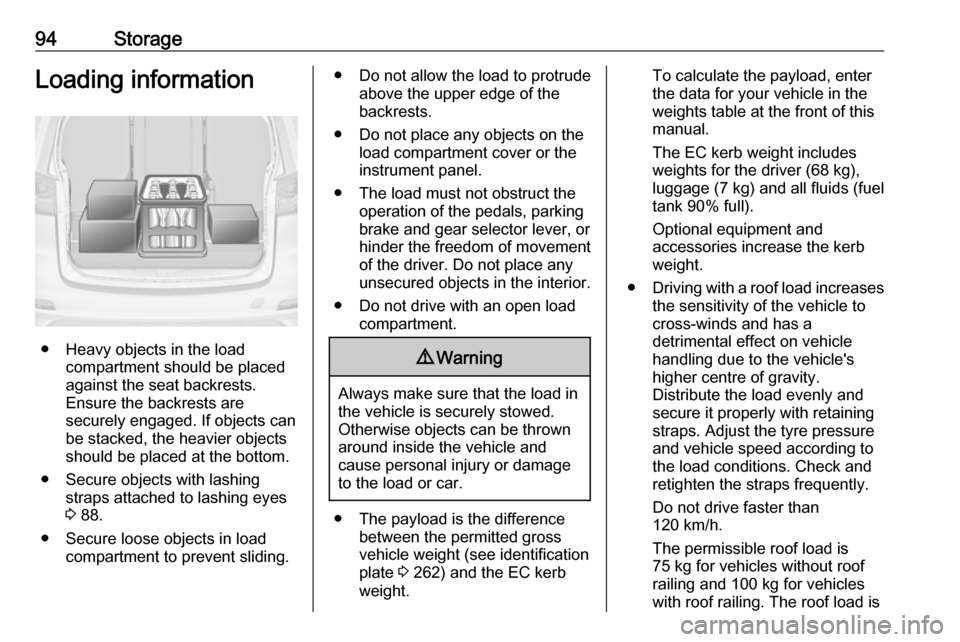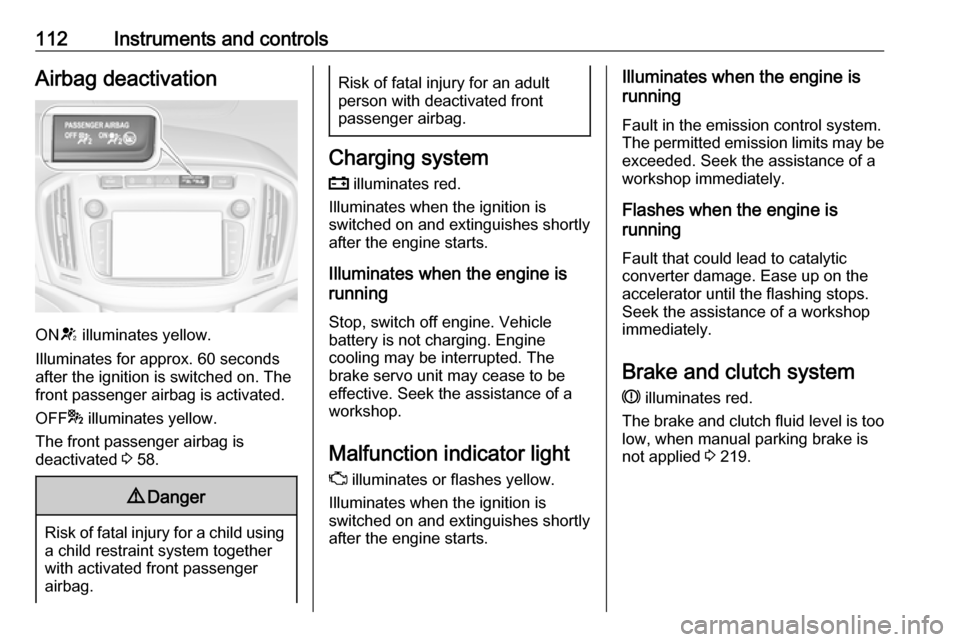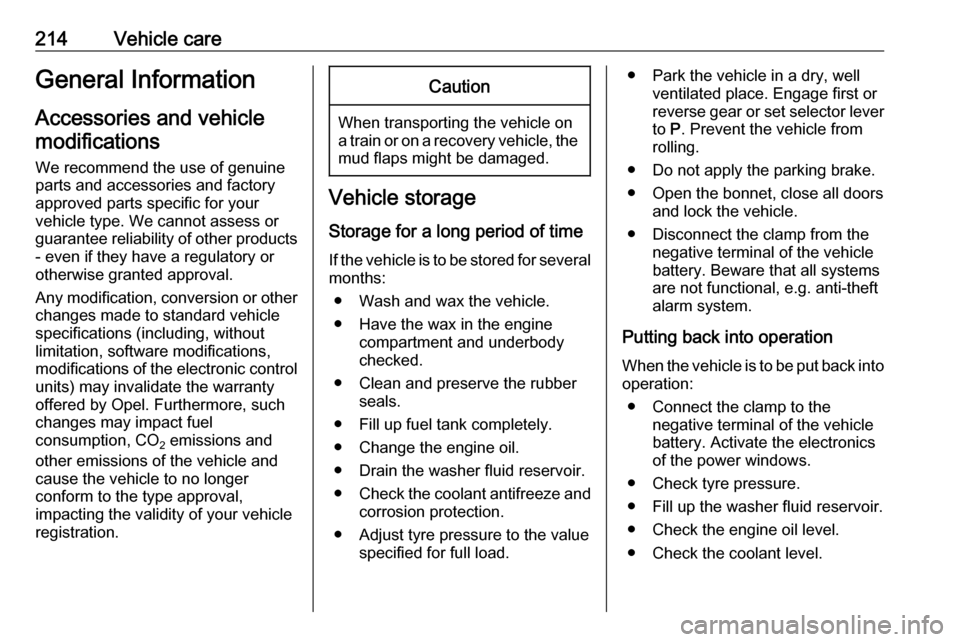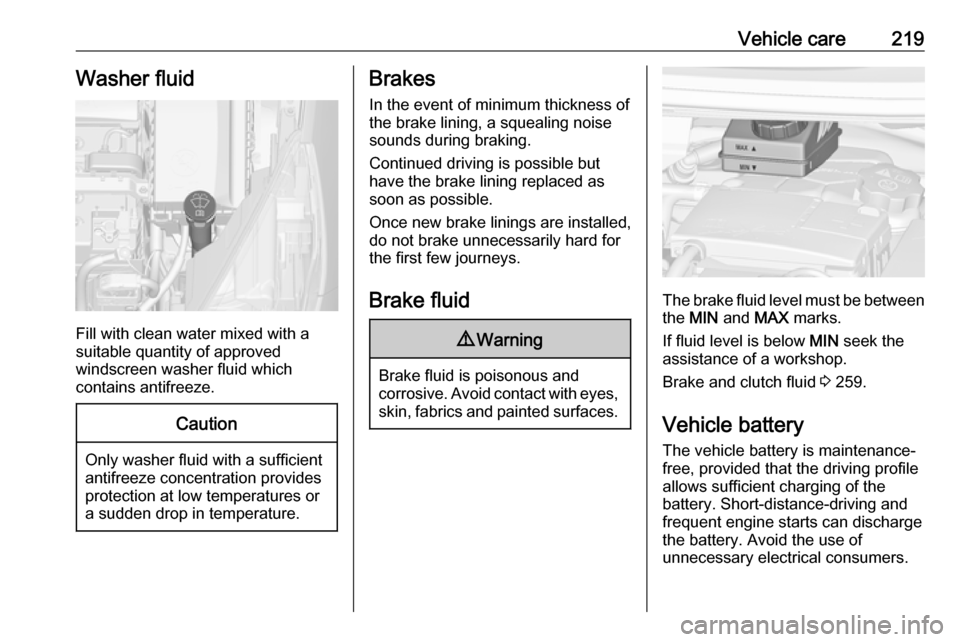brake fluid OPEL ZAFIRA C 2017.25 Manual user
[x] Cancel search | Manufacturer: OPEL, Model Year: 2017.25, Model line: ZAFIRA C, Model: OPEL ZAFIRA C 2017.25Pages: 291, PDF Size: 9.02 MB
Page 19 of 291
![OPEL ZAFIRA C 2017.25 Manual user In brief17Automatic transmissionP:park positionR:reverseN:neutral modeD:automatic modeM:manual mode<:upshift]:downshift
The selector lever can only be movedout of P when the ignition is on and
the br OPEL ZAFIRA C 2017.25 Manual user In brief17Automatic transmissionP:park positionR:reverseN:neutral modeD:automatic modeM:manual mode<:upshift]:downshift
The selector lever can only be movedout of P when the ignition is on and
the br](/img/37/18928/w960_18928-18.png)
In brief17Automatic transmissionP:park positionR:reverseN:neutral modeD:automatic modeM:manual mode<:upshift]:downshift
The selector lever can only be movedout of P when the ignition is on and
the brake pedal is applied. To engage
P or R, press the release button.
Automatic transmission 3 162.
Starting off
Check before starting off ● Tyre pressure and condition 3 237, 3 274.
● Engine oil level and fluid levels 3 216.
● All windows, mirrors, exterior lighting and number plates are
free from dirt, snow and ice and
are operational.
● Proper position of mirrors, seats, and seat belts 3 29, 3 38,
3 51.
● Brake function at low speed, particularly if the brakes are wet.Starting the engine
● Turn key to position 1.
● Move the steering wheel slightly to release the steering wheel
lock.
● Operate clutch and brake pedal. ● Automatic transmission: operate brake pedal and move selector
lever to P or N.
● Do not operate accelerator pedal.
Page 96 of 291

94StorageLoading information
● Heavy objects in the loadcompartment should be placed
against the seat backrests.
Ensure the backrests are
securely engaged. If objects can
be stacked, the heavier objects should be placed at the bottom.
● Secure objects with lashing straps attached to lashing eyes
3 88.
● Secure loose objects in load compartment to prevent sliding.
● Do not allow the load to protrudeabove the upper edge of the
backrests.
● Do not place any objects on the load compartment cover or the
instrument panel.
● The load must not obstruct the operation of the pedals, parking
brake and gear selector lever, or
hinder the freedom of movement of the driver. Do not place any
unsecured objects in the interior.
● Do not drive with an open load compartment.9Warning
Always make sure that the load in
the vehicle is securely stowed.
Otherwise objects can be thrown
around inside the vehicle and
cause personal injury or damage
to the load or car.
● The payload is the difference between the permitted gross
vehicle weight (see identification
plate 3 262) and the EC kerb
weight.
To calculate the payload, enter
the data for your vehicle in the
weights table at the front of this
manual.
The EC kerb weight includes
weights for the driver (68 kg),
luggage (7 kg) and all fluids (fuel
tank 90% full).
Optional equipment and
accessories increase the kerb
weight.
● Driving with a roof load increases
the sensitivity of the vehicle to
cross-winds and has a
detrimental effect on vehicle
handling due to the vehicle's
higher centre of gravity.
Distribute the load evenly and secure it properly with retaining
straps. Adjust the tyre pressure
and vehicle speed according to
the load conditions. Check and
retighten the straps frequently.
Do not drive faster than
120 km/h.
The permissible roof load is
75 kg for vehicles without roof
railing and 100 kg for vehicles
with roof railing. The roof load is
Page 114 of 291

112Instruments and controlsAirbag deactivation
ONV illuminates yellow.
Illuminates for approx. 60 seconds
after the ignition is switched on. The
front passenger airbag is activated.
OFF * illuminates yellow.
The front passenger airbag is
deactivated 3 58.
9 Danger
Risk of fatal injury for a child using
a child restraint system together
with activated front passenger
airbag.
Risk of fatal injury for an adult
person with deactivated front
passenger airbag.
Charging system
p illuminates red.
Illuminates when the ignition is
switched on and extinguishes shortly
after the engine starts.
Illuminates when the engine is
running
Stop, switch off engine. Vehicle
battery is not charging. Engine
cooling may be interrupted. The
brake servo unit may cease to be
effective. Seek the assistance of a
workshop.
Malfunction indicator light Z illuminates or flashes yellow.
Illuminates when the ignition is
switched on and extinguishes shortly
after the engine starts.
Illuminates when the engine is
running
Fault in the emission control system. The permitted emission limits may be exceeded. Seek the assistance of a
workshop immediately.
Flashes when the engine is
running
Fault that could lead to catalytic converter damage. Ease up on the
accelerator until the flashing stops.
Seek the assistance of a workshop
immediately.
Brake and clutch system
R illuminates red.
The brake and clutch fluid level is too low, when manual parking brake is
not applied 3 219.
Page 215 of 291

Vehicle care213Vehicle careGeneral Information...................214
Accessories and vehicle modifications .......................... 214
Vehicle storage ........................214
End-of-life vehicle recovery .....215
Vehicle checks ........................... 215
Performing work ......................215
Bonnet ..................................... 215
Engine oil ................................. 216
Engine coolant ......................... 217
Power steering fluid .................218
Washer fluid ............................ 219
Brakes ..................................... 219
Brake fluid ............................... 219
Vehicle battery ......................... 219
Diesel fuel system bleeding .....221
Wiper blade replacement ........221
Bulb replacement .......................222
Halogen headlights ..................222
LED headlights ........................ 224
Fog lights ................................. 224
Tail lights ................................. 225
Side turn signal lights ..............228
Number plate light ...................228Interior lights ............................ 229
Instrument panel illumination ...229
Electrical system ........................229
Fuses ....................................... 229
Engine compartment fuse box . 231
Instrument panel fuse box .......233
Load compartment fuse box ....234
Vehicle tools .............................. 236
Tools ........................................ 236
Wheels and tyres .......................236
Winter tyres ............................. 236
Tyre designations ....................236
Tyre pressure .......................... 237
Tyre pressure monitoring system .................................... 238
Tread depth ............................. 241
Changing tyre and wheel size . 242
Wheel covers ........................... 242
Tyre chains .............................. 242
Tyre repair kit .......................... 242
Wheel changing .......................245
Spare wheel ............................ 248
Jump starting ............................. 251
Towing ....................................... 252
Towing the vehicle ...................252
Towing another vehicle ...........253Appearance care .......................254
Exterior care ............................ 254
Interior care ............................. 256
Page 216 of 291

214Vehicle careGeneral Information
Accessories and vehicle modifications
We recommend the use of genuine
parts and accessories and factory
approved parts specific for your
vehicle type. We cannot assess or guarantee reliability of other products
- even if they have a regulatory or
otherwise granted approval.
Any modification, conversion or other changes made to standard vehicle
specifications (including, without
limitation, software modifications,
modifications of the electronic control units) may invalidate the warranty
offered by Opel. Furthermore, such
changes may impact fuel
consumption, CO 2 emissions and
other emissions of the vehicle and
cause the vehicle to no longer
conform to the type approval,
impacting the validity of your vehicle
registration.Caution
When transporting the vehicle on
a train or on a recovery vehicle, the
mud flaps might be damaged.
Vehicle storage
Storage for a long period of time
If the vehicle is to be stored for several months:
● Wash and wax the vehicle.
● Have the wax in the engine compartment and underbody
checked.
● Clean and preserve the rubber seals.
● Fill up fuel tank completely.
● Change the engine oil.
● Drain the washer fluid reservoir.
● Check the coolant antifreeze and
corrosion protection.
● Adjust tyre pressure to the value specified for full load.
● Park the vehicle in a dry, wellventilated place. Engage first or
reverse gear or set selector lever
to P. Prevent the vehicle from
rolling.
● Do not apply the parking brake.
● Open the bonnet, close all doors and lock the vehicle.
● Disconnect the clamp from the negative terminal of the vehicle
battery. Beware that all systems
are not functional, e.g. anti-theft
alarm system.
Putting back into operation
When the vehicle is to be put back into
operation:
● Connect the clamp to the negative terminal of the vehicle
battery. Activate the electronics
of the power windows.
● Check tyre pressure.
● Fill up the washer fluid reservoir.
● Check the engine oil level.
● Check the coolant level.
Page 221 of 291

Vehicle care219Washer fluid
Fill with clean water mixed with a
suitable quantity of approved
windscreen washer fluid which
contains antifreeze.
Caution
Only washer fluid with a sufficient
antifreeze concentration provides
protection at low temperatures or
a sudden drop in temperature.
Brakes
In the event of minimum thickness of
the brake lining, a squealing noise
sounds during braking.
Continued driving is possible but
have the brake lining replaced as
soon as possible.
Once new brake linings are installed,
do not brake unnecessarily hard for
the first few journeys.
Brake fluid9 Warning
Brake fluid is poisonous and
corrosive. Avoid contact with eyes, skin, fabrics and painted surfaces.
The brake fluid level must be betweenthe MIN and MAX marks.
If fluid level is below MIN seek the
assistance of a workshop.
Brake and clutch fluid 3 259.
Vehicle battery
The vehicle battery is maintenance-
free, provided that the driving profile
allows sufficient charging of the
battery. Short-distance-driving and
frequent engine starts can discharge
the battery. Avoid the use of
unnecessary electrical consumers.
Page 253 of 291

Vehicle care251Jump starting
Do not start with quick charger.
A vehicle with a discharged battery
can be started using jump leads and
the battery of another vehicle.
Do not start with quick charger.9 Warning
Be extremely careful when starting
with jump leads. Any deviation
from the following instructions can
lead to injuries or damage caused
by battery explosion or damage to the electrical systems of both
vehicles.
9 Warning
Avoid contact of the battery with
eyes, skin, fabrics and painted
surfaces. The fluid contains
sulphuric acid which can cause
injuries and damage in the event
of direct contact.
● Never expose the vehicle battery
to naked flames or sparks.
● A discharged vehicle battery can already freeze at a temperature
of 0 °C. Defrost the frozen vehicle
battery before connecting jump leads.
● Wear eye protection and protective clothing when
handling a battery.
● Use a booster vehicle battery with the same voltage (12 Volt).
Its capacity (Ah) must not be
much less than that of the
discharged vehicle battery.
● Use jump leads with insulated terminals and a cross section of
at least 16 mm 2
(25 mm 2
for
diesel engines).
● Do not disconnect the discharged
vehicle battery from the vehicle.
● Switch off all unnecessary electrical consumers.
● Do not lean over the battery during jump starting.
● Do not allow the terminals of one
lead to touch those of the other
lead.● The vehicles must not come into contact with each other during
the jump starting process.
● Apply the parking brake, transmission in neutral,
automatic transmission in P.
● Open the positive terminal protection cap of your vehicle in
the engine compartment and of
the booster vehicle battery.
Page 262 of 291

260Service and maintenanceDexos is the newest engine oil quality
that provides optimum protection for
gasoline and diesel engines. If it is unavailable, engine oils of other listed qualities have to be used.
Recommendations for gasoline
engines are also valid for
Compressed Natural Gas (CNG),
Liquified Petroleum Gas (LPG) and
Ethanol (E85) fuelled engines.
Select the appropriate engine oil
based on its quality and on the
minimum ambient temperature
3 264.
Topping up engine oil
Engine oils of different manufacturers
and brands can be mixed as long as
they comply with the required engine
oil quality and viscosity.
Use of engine oil with only
ACEA A1/B1 or only A5/B5 quality is
prohibited, since it can cause long-
term engine damage under certain
operating conditions.
Select the appropriate engine oil
based on its quality and on the
minimum ambient temperature
3 264.Additional engine oil additives
The use of additional engine oil
additives could cause damage and
invalidate the warranty.
Engine oil viscosity grades
The SAE viscosity grade gives
information of the thickness of the oil.
Multigrade oil is indicated by two
figures, e.g. SAE 5W-30. The first
figure, followed by a W, indicates the
low temperature viscosity and the
second figure the high temperature
viscosity.
Select the appropriate viscosity grade depending on the minimum ambient
temperature 3 264.
All of the recommended viscosity
grades are suitable for high ambient
temperatures.
Coolant and antifreeze
Use only organic acid type-long life
coolant (LLC) antifreeze approved for
the vehicle. Consult a workshop.
The system is factory filled with
coolant designed for excellent
corrosion protection and frost
protection down to approx. -28 °C. Innorthern countries with very low
temperatures the factory filled coolant
provides frost protection down to
approx. -37 °C. This concentration
should be maintained all year round.
The use of additional coolant
additives that intend to give additional corrosion protection or seal against
minor leaks can cause function
problems. Liability for consequences resulting from the use of additional
coolant additives will be rejected.
Brake and clutch fluid
Over time, brake fluid absorbs
moisture which will reduce braking
effectiveness. The brake fluid should
therefore be replaced at the specified interval.
Washer fluid Use only washer fluid approved for
the vehicle to prevent damage of
wiper blades, paintwork, plastic and
rubber parts. Consult a workshop.
Page 286 of 291

284IndexAAccessories and vehicle modifications .......................... 214
Active Emergency Braking .........186
Active head restraints ...................37
Adaptive cruise control .......117, 176
AdBlue ........................ 115, 159, 259
Adjustable air vents ...................148
Airbag and belt tensioners .........111
Airbag deactivation ..............58, 112
Airbag label................................... 54
Airbag system .............................. 54
Air conditioning regular operation ................................ 149
Air conditioning system .............. 143
Air intake .................................... 149
Air vents...................................... 148
Antilock brake system ................ 166
Antilock brake system (ABS) .....113
Anti-theft alarm system ................26
Anti-theft locking system .............. 26
Appearance care ........................254
Armrest ......................................... 42
Armrest storage ........................... 69
Ashtrays ..................................... 103
Automatic anti-dazzle ..................30
Automatic light control ...............133
Automatic locking ........................24
Automatic transmission .............162Autostop..................................... 154
Auxiliary heater ........................... 148
B Battery discharge protection ......141
Battery voltage ........................... 124
Bicycle rack .................................. 70
BlueInjection ............................... 159
Bonnet ....................................... 215
Brake and clutch fluid .................259
Brake and clutch system ...........112
Brake assist ............................... 168
Brake fluid .................................. 219 Brakes ............................... 166, 219
Breakdown.................................. 252
Bulb replacement ....................... 222
C Capacities .................................. 272
Cargo management system ........88
Car Pass ...................................... 21
Catalytic converter .....................158
Central locking system ................22
Centre console lighting ..............140
Centre console storage ...............69
Changing tyre and wheel size ...242
Charging system ........................ 112
Child locks ................................... 25
Child restraint installation locations ................................... 63
Child restraints.............................. 60
Page 287 of 291

285Child restraint systems ................60
Cigarette lighter .........................103
Climate control ............................. 16
Climate control systems .............142
Clock........................................... 101
Code ........................................... 123
Collision damage repair ..............280
Control indicators........................ 108
Control of the vehicle .................151
Controls ........................................ 97
Convex shape .............................. 29
Coolant and antifreeze ...............259
Cruise control ....................116, 173
Cupholders .................................. 66
Curtain airbag system .................. 58
Curve lighting.............................. 136
D Danger, Warnings and Cautions ...4
Daytime running lights ...............135
Declaration of conformity ............277
DEF ............................................ 159
Diesel exhaust fluid ....................159
Diesel fuel system bleeding .......221
Diesel particle filter .............115, 157
Door open .................................. 117
Door panel storage .......................68
Doors ............................................ 25
Driver assistance systems ..........173
Driver Information Centre ...........117Driving characteristics and
towing tips .............................. 208
Driving hints ................................ 151
E Electric adjustment ......................29
Electrical system......................... 229
Electric parking brake .........113, 166
Electric parking brake fault .........113
Electronic climate control system 144
Electronic driving programmes ..163
Electronic Stability Control.......... 170
Electronic Stability Control and Traction Control system ..........114
Electronic Stability Control off..... 114
End-of-life vehicle recovery .......215
Engine compartment fuse box ...231
Engine coolant ........................... 217
Engine coolant temperature gauge ..................................... 107
Engine data ............................... 267
Engine exhaust .......................... 157
Engine identification ...................263
Engine oil ................... 216, 259, 264
Engine oil pressure ....................115
Entry lighting .............................. 140
Event data recorders ..................282
Exit lighting ................................ 140
Exterior care .............................. 254
Exterior light ............................... 116Exterior lighting ....................13, 132
Exterior mirrors ............................. 29
F
Fault ........................................... 164
First aid kit ................................... 92
Fixed air vents ........................... 149
Flex-Fix system ............................ 70
Fog light ..................................... 116
Fog lights ................................... 224
Folding mirrors ............................. 29
Folding tray .................................. 92
Following distance ......................114
Following distance indication ......185
Forward collision alert................. 182
Front airbag system .....................57
Front fog lights ........................... 137
Front seats.................................... 38
Front storage ................................ 68
Fuel............................................. 198
Fuel consumption - CO 2-
Emissions ............................... 207
Fuel for diesel engines ..............199
Fuel for liquid gas operation .......200
Fuel for natural gas operation ...199
Fuel for petrol engines ...............198
Fuel gauge ................................. 105
Fuel selector .............................. 106
Fuses ......................................... 229